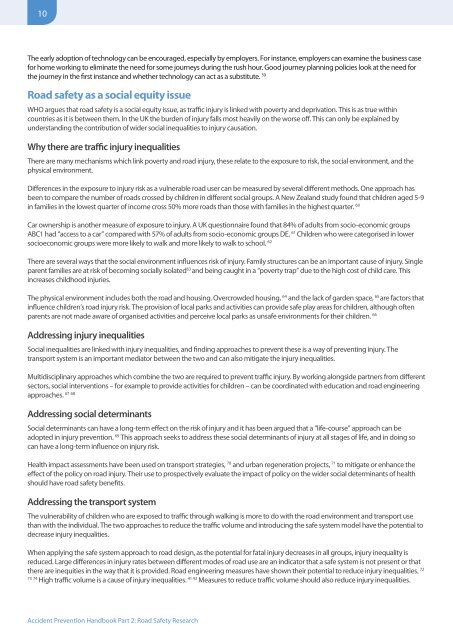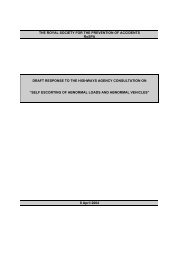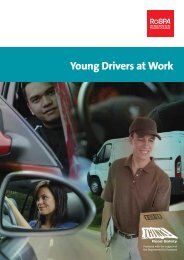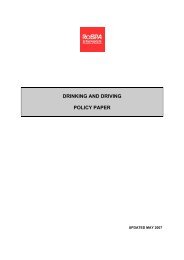Road safety policy and links to wider objectives - RoSPA
Road safety policy and links to wider objectives - RoSPA
Road safety policy and links to wider objectives - RoSPA
You also want an ePaper? Increase the reach of your titles
YUMPU automatically turns print PDFs into web optimized ePapers that Google loves.
10<br />
The early adoption of technology can be encouraged, especially by employers. For instance, employers can examine the business case<br />
for home working <strong>to</strong> eliminate the need for some journeys during the rush hour. Good journey planning policies look at the need for<br />
the journey in the first instance <strong>and</strong> whether technology can act as a substitute. 59<br />
<strong>Road</strong> <strong>safety</strong> as a social equity issue<br />
WHO argues that road <strong>safety</strong> is a social equity issue, as traffic injury is linked with poverty <strong>and</strong> deprivation. This is as true within<br />
countries as it is between them. In the UK the burden of injury falls most heavily on the worse off. This can only be explained by<br />
underst<strong>and</strong>ing the contribution of <strong>wider</strong> social inequalities <strong>to</strong> injury causation.<br />
Why there are traffic injury inequalities<br />
There are many mechanisms which link poverty <strong>and</strong> road injury, these relate <strong>to</strong> the exposure <strong>to</strong> risk, the social environment, <strong>and</strong> the<br />
physical environment.<br />
Differences in the exposure <strong>to</strong> injury risk as a vulnerable road user can be measured by several different methods. One approach has<br />
been <strong>to</strong> compare the number of roads crossed by children in different social groups. A New Zeal<strong>and</strong> study found that children aged 5-9<br />
in families in the lowest quarter of income cross 50% more roads than those with families in the highest quarter. 60<br />
Car ownership is another measure of exposure <strong>to</strong> injury. A UK questionnaire found that 84% of adults from socio-economic groups<br />
ABC1 had “access <strong>to</strong> a car” compared with 57% of adults from socio-economic groups DE. 61 Children who were categorised in lower<br />
socioeconomic groups were more likely <strong>to</strong> walk <strong>and</strong> more likely <strong>to</strong> walk <strong>to</strong> school. 62<br />
There are several ways that the social environment influences risk of injury. Family structures can be an important cause of injury. Single<br />
parent families are at risk of becoming socially isolated 63 <strong>and</strong> being caught in a “poverty trap” due <strong>to</strong> the high cost of child care. This<br />
increases childhood injuries.<br />
The physical environment includes both the road <strong>and</strong> housing. Overcrowded housing, 64 <strong>and</strong> the lack of garden space, 65 are fac<strong>to</strong>rs that<br />
influence children’s road injury risk. The provision of local parks <strong>and</strong> activities can provide safe play areas for children, although often<br />
parents are not made aware of organised activities <strong>and</strong> perceive local parks as unsafe environments for their children. 66<br />
Addressing injury inequalities<br />
Social inequalities are linked with injury inequalities, <strong>and</strong> finding approaches <strong>to</strong> prevent these is a way of preventing injury. The<br />
transport system is an important media<strong>to</strong>r between the two <strong>and</strong> can also mitigate the injury inequalities.<br />
Multidisciplinary approaches which combine the two are required <strong>to</strong> prevent traffic injury. By working alongside partners from different<br />
sec<strong>to</strong>rs, social interventions – for example <strong>to</strong> provide activities for children – can be coordinated with education <strong>and</strong> road engineering<br />
67 68<br />
approaches.<br />
Addressing social determinants<br />
Social determinants can have a long-term effect on the risk of injury <strong>and</strong> it has been argued that a “life-course” approach can be<br />
adopted in injury prevention. 69 This approach seeks <strong>to</strong> address these social determinants of injury at all stages of life, <strong>and</strong> in doing so<br />
can have a long-term influence on injury risk.<br />
Health impact assessments have been used on transport strategies, 70 <strong>and</strong> urban regeneration projects, 71 <strong>to</strong> mitigate or enhance the<br />
effect of the <strong>policy</strong> on road injury. Their use <strong>to</strong> prospectively evaluate the impact of <strong>policy</strong> on the <strong>wider</strong> social determinants of health<br />
should have road <strong>safety</strong> benefits.<br />
Addressing the transport system<br />
The vulnerability of children who are exposed <strong>to</strong> traffic through walking is more <strong>to</strong> do with the road environment <strong>and</strong> transport use<br />
than with the individual. The two approaches <strong>to</strong> reduce the traffic volume <strong>and</strong> introducing the safe system model have the potential <strong>to</strong><br />
decrease injury inequalities.<br />
When applying the safe system approach <strong>to</strong> road design, as the potential for fatal injury decreases in all groups, injury inequality is<br />
reduced. Large differences in injury rates between different modes of road use are an indica<strong>to</strong>r that a safe system is not present or that<br />
there are inequities in the way that it is provided. <strong>Road</strong> engineering measures have shown their potential <strong>to</strong> reduce injury inequalities. 72<br />
73 74 High traffic volume is a cause of injury inequalities. 41 43 Measures <strong>to</strong> reduce traffic volume should also reduce injury inequalities.<br />
Accident Prevention H<strong>and</strong>book Part 2: <strong>Road</strong> Safety Research

















